
Citation: MV Ragavendra Rao, et al. Anti-Allergic Studies of Albizzia Lebbeck and Syzygium Cumini (L- Syzygium Gambolana). Op Ac Jo Micbiol & Bitechnol, 2016, 1(1): 000103.
*Corresponding author: MV Raghavendra Rao, Professor of Microbiology, Dean student affairs, Avalon University School of Medicine, Sta. Rosaweg 122-124, Willemstad Curacao, Netherlands Antilles, Tel: +5999-691-0461; Email: reachdrmvrrao@gmail.com
The anti-allergic effects of herbs Albizzialebbeckand Syzygium cumin were analyzed in wistar albino rats and Swiss albino mice, from the aqueous and methanol extracts of roots of these plants. Mast cell degranulation in rats was induced by clonidine and as a known factor d-disodium chromoglycolate administration and the extracts showed a significant reduction in mast cell degranulation, suggesting a possible antihistamine and anti-allergic actions. Clonidine induced catalepsy was reduced by a known chemical diphenhydramine. Clonidine induced catalepsy was also shown to be reduced to a lesser extent by the extracts. Milk induced Leukocytosis was reduced by Diazepam and it was compared with the extracts. Extracts also caused significant reduction in milk induced leukocytosis, but to a lesser extent than diazepam. Milk induced eosinophilia was reduced by Dexamethasone and it was compared with the extracts. Extracts also caused significant reduction in milk induced leukocytosis, but to a lesser extent than Dexamethasone. With these results it is indicated that roots of Albizzialebbeck and Syzygium cumin have anti-allergic effects.
Medicinal Herbs are moving from fringe to mainstream use with a greater number of people seeking remedies and health approaches free from side effects caused by synthetic chemicals. Recently, considerable attention has been paid to utilize eco-friendly and bio friendly plant-based products for the prevention and cure of different human diseases [1-5]. Considering the adverse effects of synthetic drugs, the Western population is looking for natural remedies, which are safe and effective [6,7]. It is documented that 80% of the world’s population has faith in traditional medicine, particularly plant drugs for their primary healthcare. The various sutras in ayurveda [8], illustrates that a person undergoing rejuvenation therapy attains longevity, memory, intellect, freedom from diseases, youth, excellence of luster, true sense-organ and respect, brilliance and vak-siddhi (i.e. what he says comes true). This rejuvenation therapy is known as Rasayana therapy. The materials used in the therapy are termed as Rasayana. The golden age of Ayurveda was over after Vāgbhat. The period of stagnation, which followed lasted a thousand years when advances became a trickle, such as the advent of counting pulse, use of mercury and opium in treatment and the description of syphilis. But there were no more Carakas or Suśrutas and no more Taks, Aśilas or Nalandas [9].
Albizzialebbeck Benth is found throughout India, Bangladesh, tropical and subtropical Asia and Africa. Barks are used in toothache and diseases of the gum. Decoction of the leaves and barks are protective against bronchial asthma and other allergic disorders.
Syzygiumcumini Linn also known as Syzygiumgambolana is also known as Java plum medicinally, the fruit is stated to be astringent, stomachic, and carminative, antiscorbutic and diuretic. Allergy is a disorder of the immune system often also referred to as atopsy. Allergic reactions occur to environmental substances known as allergens; these reactions are acquired, predictable and rapid. Strictly, allergy is one of four forms of hypersensitivity and is called type I (or immediate) hypersensitivity.
The use of medicinal plant products as possible prophylactic/ therapeutic measure for the modulation of immune response and development of diseases has become a subject of scientific investigations. It is being now recognized that immune modulatory therapy and revitalization therapy could prove an attractive alternative to conventional chemotherapy in various diseased conditions, especially when host’s defense mechanisms have to be activated under the conditions of impaired immune responsiveness and impaired organ function [10-13].
Albizzialebbeck (Figure 1)
Family: Fabaceae / Mimosaceae
Species: Albizzialebbeck
Common name(s):+ Siris Tree, Albizzia, Indian Siris Tree
Albizzialebbeck belongs to family leguminosae, easily grown from seed and very persistent fruit hanging down in conspicuous clusters. This genus is represented throughout the tropics. The foliage is commonly used as fodder in India and elsewhere for cattle, and in Sudan, goat eats fallen leaves and flowers.
Syzygiumcumini (Figure 2)
Class : Magnliopsida
Superorder : Rosanae
Order : Myrtales
Family : Myrtaceae
Genus : Syzygium
A member of the family, Myrtaceae, the jambolan (Syzygiumcumini Skeels; syns. S. jambolanum DC, Eugenia cumini Druce, E. jambolanaLam., E. djouatPerr., Myrtuscumini L., CalyptranthesjambolanaWilld.) is also known as Java plum and by various other colloquial names such as Portuguese plum, Malabar plum, black plum, Indian blackberry, jaman, jambu, jambul, jambool and duhat. The fruits are edible and are reported to contain gallic acid, tannins, anthocyanins and other components [12]. The juice of unripe fruits is used for preparing vinegar that is considered to be a stomachic, carminative and diuretic.
Materials and methodsAdult albino rats (Wistar strain) of either sex weighing 200-250g and male swiss albino mice weighing 22-25 g were used in the entire study. Each pair of animal was housed in a spacious polypropylene cage containing wood shavings as nesting material, which was maintained at 23ºC 3C in a well-ventilated animal house under natural photoperiod condition.
Preparation of Albizzialebbeck and Syzygiumcumini
The Albizzialebbeck and Syzygiumcumini (1:1) roots were shade dried and powdered. The roots were defatted with petroleum ether (60-80º) and further extracted with distilled water (Albizzialebbeck and Syzygiumcumini Water), methanol (Albizzialebbeck and Syzygiumcumin Methanol) and under soxhale extraction and methonolic fraction of aqueous extract (ASMW) was prepared.
Results and DiscussionAllergy is characterized by an over-reaction of the human immune system to foreign protein substance (allergen) that is eaten, breathed into the lungs, injected or touched. This immune over-reaction can result in symptoms such as coughing, sneezing and itching in eyes, runny nose and secretory throat. Today allergy is the 5th leading chronic disease and round 60 million people suffer from all types of allergies. Allergies are often tricky to diagnose and treat for a number of reasons. Allergies may also show up suddenly in someone with no previous history of sensitivity to an allergen. During allergy, there is sensitization of the mast cells which cause the release of mediators like histamine, cytokines, leukotrienes etc. as well as disposition of the proinflammatory cells like eosinophils and leucocytes.
Allergy control medicines are taken daily over a long period of time to prevent allergic symptoms form developing. But there are certain limitations to this conventional therapy. Antihistamines block the effects of histamine rather than to stop its production. Cromolyn sodium usually affects only the areas where it is applied, such as the back of the throat, lungs, eyes, or nose. When taken by mouth, cromolyn is not absorbed into the bloodstream. Corticosteroids can be taken as a nasal spray to treat nasal symptoms or through an inhaler, usually to treat asthma. If symptoms are very severe or widespread, taking as corticosteroid (such as prednisone) by mouth may be necessary. If taken by mouth for more than 3 to 4 weeks, corticosteroids have many, sometimes serious side effects.
Allergic reactions are a very common and important set of symptoms for herbalists to learn to recognize and treat. +They are a grouping of immunological reactions rather than a single disease. While their consequences are occasionally lifethreatening (anaphylaxis and shock), there are many other less hazardous circumstances where the experienced herbalist can mitigate symptoms and offer relief. Herbal drugs have been used since ancient times as medicines for the treatment of a range of diseases. During the past few decades, public interest in natural therapies, namely herbal medicine, has increased dramatically not only in developing countries but mainly in industrialized countries. The present study indicated that the extracts. ASW, ASM, ASWM inhibited clonidine-induced catalepsy.
Mast Cell DegranulationMast cells are resident in all the normal tissues where they are believed to play important role in tissue homeostasis, wound healing and host defense. The mast cells respond to various physiological and chemical stimuli with the expulsion of granules which then releases the active substances into the extracellular medium. The expulsion is due to an active energy-dependent discharge process. The intracellular Ca+2 ions are the critical functional compartments in the degranulation of mast cells.
The transduction pathways modulating the intracellular Ca+2 are modified by G-protein binding protein. IgE initiates the activation of signal transduction pathway which leads to the release of histamine. Compound 48/80 increases the permeability of lipid bilayer membrane by causing the perturbation in the membrane. Clonidine causes mast cell degranulation in similar way as that of compound 40/80 by dynamic expulsion of granules without damaging cell well.
The degranulation of mast cells was increased significantly in group 2 (p<0.01) as compared to group 1 (control). The degranulation of mast cells was significantly protected in group 2 and group 4 (p<0.01) and in group 6 (p<0.001) as compared to group 2 (DSCG) (Table 1). In present study, disodium cromoglycate and the extracts ASW, ASM and ASWM significantly protected mast cell degranulation against clonidine in a dose dependent manner. This may be attributed to+antihistaminic or antiallergic effect of the extracts when administered to the animal. (Table 1)
Values are expressed as mean ± SEM, n = 6. DSCG is ddisodium chromoglycolate administered at the dose of (50mg/kg, body weight, i.p.), ASW is aqueous extract of Albizzialebbeck and Syzygiumgambolana, sweet (1 ml/kg body weight, i.p.), ASM is Methanolic extract of Albizzialebbeck and Syzygiumgambolana, sweet (1ml/kg body weight, i.p.), ASWM is Methanolic Fraction of aqueous extract of ,i>Albizzialebbeck and Syzygiumgambolana, sweet (1ml/kg body weight, i.p.). P values: a: <0.05, b :<0.01, c:<0.001 When group 2 is compared with group 1; Group 4, 5 and 6 are compared with group 2. NS means not significant.
Clonidine Induced Catalepsy Effect of Diphenhydramine on Clonidine induced catalepsy in mice.Clonidine is known to induce the catalepsy in experimental animals by increasing the release of histamine in the certain brain regions. In the present study, the duration of catalepsy was increased in group I (Control) after subcutaneous administration of clonidine (1 mg / kg) in experimental animals.
Some established antihistaminic compounds when used along with the clonidine significantly block the cataleptic effect of clonidine. The duration of catalepsy was significantly decreased in group II [Diphenhydramine (1 mg / kg, i. p.) + Clonidine (1mg / kg, s.c.)] at time 30 minute (p <0.05), 60 minutes (p < 0.01), 90 minutes (p < 0.001) and 120 minutes (p <0.01) as compared to group I control (Table 2). Several drugs are known to induce catalepsy in animals. Histamine containing mast calls are present in brain. Mast cell degranulation and its correlation with the release of histamine after administration of compound 48/80 are studied. Clonidine induces does dependent catalepsy in mice which is inhibited by histamine H4-receptor antagonists. It is known that clonidine releases histamine from mast cells. The intracerebral ventricular injection of histamine in conscience mice induces catalepsy, which was inhibited by H4-antagonists. (Table 2)Values are expressed as mean ± SEM, n = 6.
Effect of extract of Albizzialebbeck and Syzygiumcumini roots (ASW) on clonidine induced catalepsy in miceDuration of catalepsy was increased significantly (p<0.05) in group I (Control) after subcutaneous administration of clonidine (1 mg / kg) in experimental animals. Various plant materials, herbal extracts were used as antiallergic agents from a long time. These herbal plant materials might be containing some type of antihistaminic or antiallergic type of compounds therefore inhibiting the allergic type of reactions. We also found the same type of action when our extracts were administered to clonidine challenged animals. Duration of catalepsy was significantly decreased in group II [ASW (1 ml/kg body weight, i.p.) + Clonidine (1mg / kg, s.c.)] at time 30 minute (p<0.05), 60 minutes (p < 0.01), 90 minutes (p < 0.01) and 120 minutes (p<0.05) as compared to group I control (Table 3).
Effect of extract of Albizzialebbeck and Syzygiumcumini roots (ASM) on clonidine induced catalepsyDuration of catalepsy was increased in group I (Control) after subcutaneous administration of clonidine (1 mg / kg) in experimental animals. Duration of catalepsy was significantly decreased in group II [ASM (1 ml/kg body weight, i.p.) + Clonidine (1mg / kg, s.c.)] at time 30 minute (p <0.05), 60 minutes (p < 0.01), 90 minutes (p < 0.01) and 120 minutes (p <0.05) as compared to group I control (Table 4). This is clearly indicating that, the extract ASM having its peak pharmacological action at 60 and 90 minutes and secondly it is also indicated from the above experiment that the extract ASM is having significant anti-histaminic and anticataleptic like action.
Effect of extract of Albizzialebbeck and Syzygiumcumini roots (ASWM) on clonidine induced catalepsy in miceDuration of catalepsy was increased in group I (Control) after subcutaneous administration of clonidine (1 mg / kg) in experimental animals. Duration of catalepsy was significantly decreased in group II [ASWM (1 ml/kg body weight, i.p.) + Clonidine (1mg / kg, s.c.)] at time 30 minute (p <0.05), 60 minutes (p < 0.01), 90 minutes (p < 0.01) and 120 minutes (p <0.05) as compared to group I control (Table 5) indicating that highly significant anticataleptic action at 60 and 90 minutes rather that 30 and 120 minutes after administration of clonidine.
Values are expressed as mean ± SEM, n = 6.
Group II is compared with group I.
P values: a: <0.05, b:<0.01, c:<0.001, ns – non-significant.
(One-way ANOVA at different time intervals, followed by Dunnett’s test)
Milk Induced LeukocytosisThe milk induced and increases in leukocyte count in group I (control) in mice 24 hour after subcutaneous injection of milk (4 ml / kg). The milk induced leukocytosis was significantly (p < 0.001) reduced in mice of group II (Diazepam 1 mg / kg, i.p.) as compared to group I (control) after 24 hrs of subcutaneous injection of milk (4 ml / kg).
The treatment with various extracts of Albizzialebbeck and Syzygiumcumini has significantly (p < 0.001) reduced the milk induced leukocytosis in group III (ASW), group IV (ASM) and group V (ASWM) as compared to group I (control) (Table 6).
Subcutaneous injection of milk was known to produce an infection like condition by acting as an antigen and increasing the leukocyte count. The leucocytes are recruited during stress and allergic responses and release the inflammatory mediators like cytokines, histamine, and major basic proteins promoting the ongoing inflammation. An adaptive may have normalization that revealed itself irrespective of the direction of previous pathologic shift. The normalization action can be obtained from leukocytosis after parenteral administration of milk. Extracts ASW, ASM and ASWM significantly in hibits milkinduced leukocytosis. This suggests that all the extracts exhibited anti-inflammatory effects during allergy.
ASW is aqueous extract of Albizzialebbeck and Syzygiumcumini, sweet (1 ml/kg body weight, i.p.), ASM is Methanolic extract of Albizzialebbeck and Syzygiumcumini, sweet (1ml/kg body weight, i.p.), and ASWM is Methanolic Fraction of aqueous extract of Albizzialebbeck and Syzygiumcumini, sweet (1ml/kg body weight, i.p.).
Milk Induced EosinophiliaThe milk induced and increases in eosinophil count in group I (control) in mice 24 hrs. After subcutaneous injection of milk (4 ml / kg). The milk induced Eosinophilia was significantly (p < 0.001) reduced in mice of group II (Dexamethasone1 mg / kg, i.p.) as compared to group I (control) after 24 hrs. Of subcutaneous injection of milk (4 ml / kg). The treatment with various extracts of Albizzialebbeck and Syzygiumcumini has significantly reduced the milk induced eosinophilia in group III (ASW) (p < 0.05), group IV (ASM) ( p < 0.05) and group V (ASWM) ( p < 0.001) as compared to group I (control- Table 7).
Eosinophilia is associated with allergic disorders together with pulmonary infiltrates that are detectable on chest films. Though eosinophils can increase in number of body fluids and tissues, emphasis placed on the number of eosinophils in blood. The late phase reaction to an allergen often coincided with an increased number of eosinophils in the airways. In addition to the regulatory role, the Th4 cell induces the inflammatory response in allergy. Pretreatments with extracts ASW, ASM and ASWM significantly inhibited milk-induced eosinophilia in a dose dependent manner.
ASW is aqueous extract of Albizzialebbeck and Syzygiumcumini, sweet (1 ml/kg body weight, i.p.), ASM is Methanolic extract of Albizzialebbeck and Syzygiumcumini, sweet (1ml/kg body weight, i.p.), and ASWM is Methanolic Fraction of aqueous extract of Albizzialebbeck and Syzygiumcumini (1ml/kg body weight, i.p.).
Summary and conclusionThe antiallergic studies were one of the part of this study, it has to be noted that there was significant protection of mast cells with co-administration of aqueous, methanolic and methanolic fraction of aqueous extract of Albizzialebbeck and Syzygiumcumini was seen indicating the antiallergic property of these extracts. There was significant reduction in the cataleptic timing by acute administration of these extracts to the animals pretreated with clonidine like compound. The catalepsy induced by clonidine is an indication of generation of allergic/histaminic action. Protection in this kind of acute clonidine toxicity is a direct indication of potential antiallergic property of these extracts.
Milk when administered subcutaneously causes leukocytosis. This is one of the important models giving direct indication of antiallergic action of any compound. There was significant increase in milk induced leukocytosis in animals on subcutaneous administration of milk. Similarly, the antiallergic compounds protects such type of leukocytosis. It is being found this present study that, the all the extracts have shown significant protection to the leukocytosis induced by milk in experimental animals. Similarly, there was a significant protection shown by all these extracts in milk induced eosinophilia model. This is again an indication of antiallergic action of these extracts.
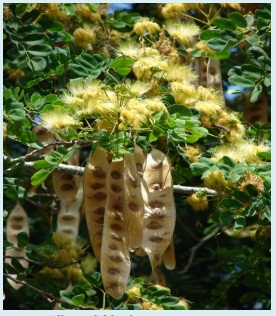
Figure 1: Albizzialebbeck
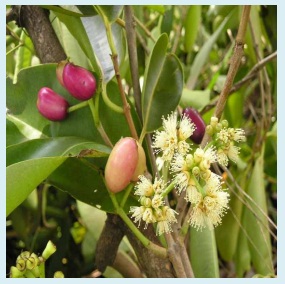
Figure 2: Syzygiumcumini
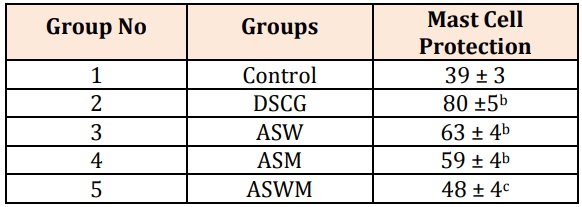
Table 1: Effect of administration of several extracts of Albizzialebbeck and Syzygiumcumini extracts on the clonidine induced mast cell degranulation in mice.
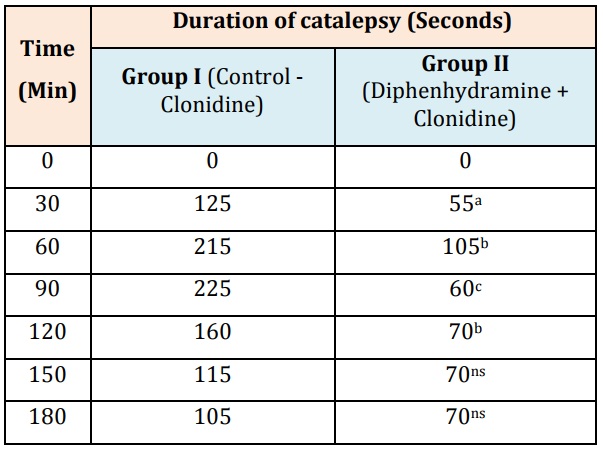
Table 2: Effect of Diphenhydramine on Clonidine induced catalepsy in mice
Group II is compared with group I.
P values: a: <0.05, b:<0.01, c:<0.001, ns – non-significant. (One-way ANOVA at different time intervals, followed by Dennett’s test)
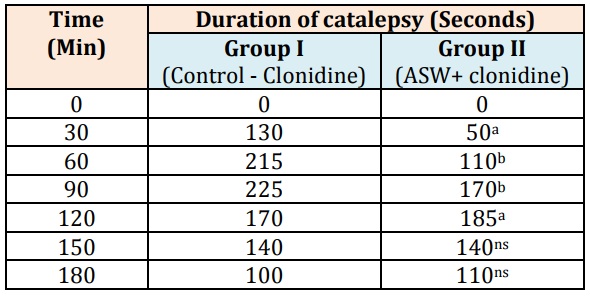
Table 3: Effect of extract of Albizzialebbeck and Syzygiumcumini roots (ASW) on clonidine induced catalepsy in mice.Values are expressed as mean ± SEM, n= 6.
Group II is compared with group I.
P values: a: <0.05, b:<0.01, c:<0.001, ns – non-significant. (One-way ANOVA at different time intervals, followed by Dennett’s test)
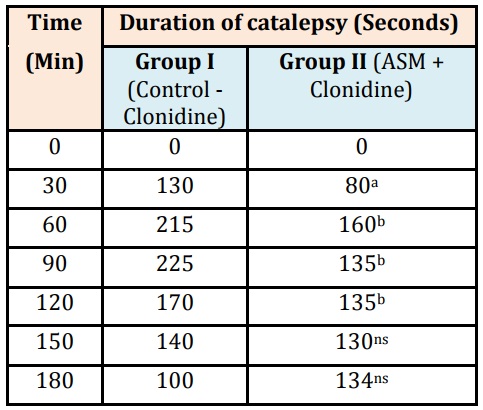
Table 4: Effect of extract of Albizzialebbeck and Syzygiumcumini roots (ASM) on clonidine induced catalepsy in mice.
Values are expressed as mean ± SEM, n = 6.
Group II is compared with group I.
P values: a: <0.05, b:<0.01, c:<0.001, ns – non-significant. (One-way ANOVA at different time intervals, followed by Dennett’s test)

Table 5: Effect of extract of Albizzialebbeck and Syzygiumcumini roots (ASWM) on clonidine induced catalepsy in mice.
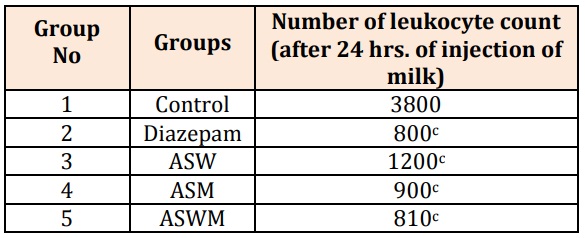
Table 6: Effect of various treatments with Diazepam and extracts of Albizzialebbeck and Syzygiumcumini on Milk Induced Leukocytosis in mice.
Values are expressed as mean ± SEM, n = 5.
Group II, III, IV & V are compared with group I.
P values: a: <0.05, b:<0.01, c:<0.001, ns – non-significant. (One-way ANOVA followed by Dunnett’s test) P values: a: <0.05, b:<0.01, c:<0.001, NS means not significant.
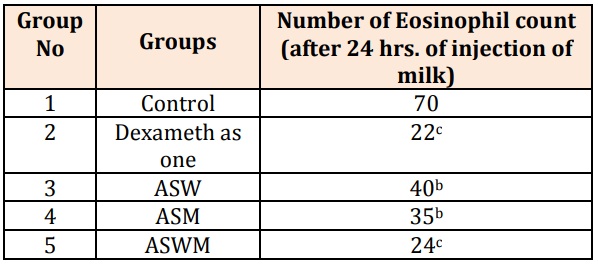
Table 7: Effect of various treatments with Dexamethasone and extracts of Albizzialebbeck and Syzygiumcuminion Milk Induced Eosinophiliain mice.
Values are expressed as mean ± SEM, n = 5.
Group II, III, IV & V are compared with group I.
P values: a: <0.05, b:<0.01, c:<0.001, ns – non-significant.
(One-way ANOVA followed by Dennett’s test) P values: a: <0.05, b:<0.01, c:<0.001 When group 2, 3, 5 and 7 are compared with group 1; Group 4, 6 and 8 are compared to group 2, NS means not significant.
Chat with us on WhatsApp